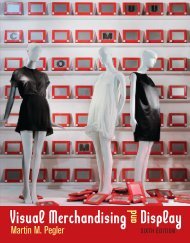You also want an ePaper? Increase the reach of your titles
YUMPU automatically turns print PDFs into web optimized ePapers that Google loves.
Table 4.2 Yarn number Conversions<br />
Woolen Linen<br />
Denier Worsted Cotton (Run) (Lea) Tex Metric<br />
50* 160 106 56 298 5.6 180<br />
Fine yarns<br />
range<br />
75 106 72 37 198 8.3 120<br />
100 80 53 28 149 11.1 90<br />
150 53 35 19 99 16.6 60<br />
Medium 200 40 27 14 74 22.2 45<br />
yarns range 300 27 18 9.3 50 33.4 30<br />
400 20 13 7.0 37 44.4 22.5<br />
500 16 11 5.6 30 55.5 18<br />
700 11.4 7.6 4.0 21 77.7 12.9<br />
Coarse<br />
yarns range<br />
1000 8.0 5.3 2.8 15 111 9<br />
1500 5.3 3.5 1.9 10 166 6<br />
2000 4.0 2.7 1.4 7 222 4.5<br />
* Much finer filament yarns, as low as 10 denier, are commonly used.<br />
60/1 60/1 60/1 60/1 60/1 100d 100d 100d<br />
60/2 30/1 60/3 20/1 100d/3-ply 300d<br />
a b<br />
c<br />
singles equivalent singles equivalent singles equivalent<br />
designating all yarn sizes. The International Organization<br />
for Standardization (ISO) has adopted this system<br />
and it is utilized in the sewing thread business.<br />
The tex system is a direct numbering system in which<br />
higher tex numbers correspond to increasingly heavier<br />
(thicker) yarns. The tex standard uses grams per 1,000<br />
meters. Thus, a 10 d yarn used for pantyhose would be<br />
equivalent to a 1.1 tex yarn. Decitex (dtex) is often<br />
used when referring to a very low tex number. Thus 5.6<br />
tex would be 560 dtex.<br />
Sewing Threads<br />
Sewing threads are special kinds of yarns that are engineered<br />
and designed to pass through a sewing machine<br />
rapidly, to form a stitch efficiently, and to function<br />
while in a sewn product without breaking or becoming<br />
YARNS AND SEWING THREADS<br />
A 83 F<br />
distorted for at least the useful life of the product.<br />
How adequately a specific thread performs these tasks<br />
depends on proper thread selection for the specified<br />
fabric and seam type used. American & Efird, Inc., is a<br />
major thread manufacturer.<br />
Fibers Used for Threads<br />
Figure 4.15<br />
Ply yarn and singles equivalents:<br />
(a) spun yarn, (b) spun yarn, and<br />
(c) filament yarn.<br />
The fibers used for sewing threads are primarily cotton,<br />
nylon, polyester, and rayon. Cotton-covered polyester<br />
is the most widely used because of its relatively low<br />
cost and high versatility. The properties and characteristics<br />
of each of the fibers prevail when they are used<br />
as threads, and these properties should be considered<br />
in thread selection for specific end uses. Rayon, for<br />
example, is usually used for thread intended primarily<br />
for embroidery or decorative stitch work rather than for<br />
seaming to hold parts together.













